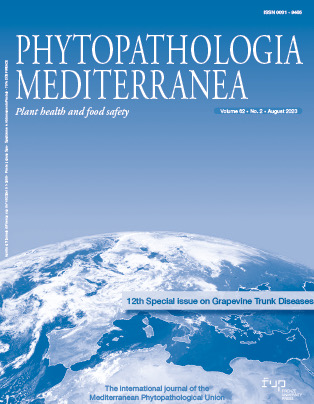Published 2023-09-15
Keywords
- Grapevine Trunk Disease,
- disease resistance,
- Vitis vinifera
How to Cite
Copyright (c) 2023 Renaud TRAVADON, Kendra BAUMGARTNER

This work is licensed under a Creative Commons Attribution 4.0 International License.
Funding data
-
U.S. Department of Agriculture
Grant numbers National Clonal Germplasm Repository
Abstract
Eutypa dieback of grapevine is a trunk disease that affects vineyard productivity. Wood symptoms of this disease develop consistently in greenhouse-grown plants, after inoculation of woody stems with the causal fungus Eutypa lata. Wood symptoms are a common measure of host cultivar resistance and E. lata isolate virulence. Leaf symptoms of the disease also develop in the greenhouse, although reports of low correlations between severity of wood and leaf symptoms (for some cultivars and isolates) indicate that a definitive procedure is required for evaluating cultivar resistance. Three ‘phenotyping assays’, replicated with two E. lata isolates (BX1-10 and M14), were assessed for quantifying resistance of a set of Vitis vinifera cultivars (‘Black Corinth’, ‘Carignane’, ‘Husseine’, ‘Merlot’, ‘Muscat Hamburg’, ‘Palomino’, ‘Peloursin’, ‘Primitivo’, and ‘Thompson Seedless’). The methods were: Assay 1 (leaf and woody-stem symptoms measured 1 year post-inoculation on plants propagated from rooted, dormant cuttings); Assay 2 (green stem symptoms measured 4 months post-inoculation on plants propagated from rooted, green cuttings); and Assay 3 (leaf symptoms measured 6 weeks post-inoculation on plants propagated from rooted, dormant cuttings). High rates of mortality among some cultivars (‘Merlot’) in Assay 3 confounded results based on leaf symptoms. Results from Assays 1 and 2 were more consistent with each other, especially for the most resistant cultivars [‘Merlot’ and ‘Primitivo’ (aka ‘Zinfandel’)]’, than they were for these cultivars in Assay 3. Compared to resistant cultivars, there was more variation in the most susceptible cultivar, including ‘Black Corinth’, ‘Carignane’, ‘Husseine’, and ‘Thompson Seedless’, regardless of the assay. Assay 1 with isolate BX1-10 was the most repeatable and provided data on wood and leaf symptoms for cultivar comparisons. Assay 2 was the most rapid, and gave results similar to those from Assay 1. Assay 2 also accommodated germplasm that can only be propagated from green cuttings.






